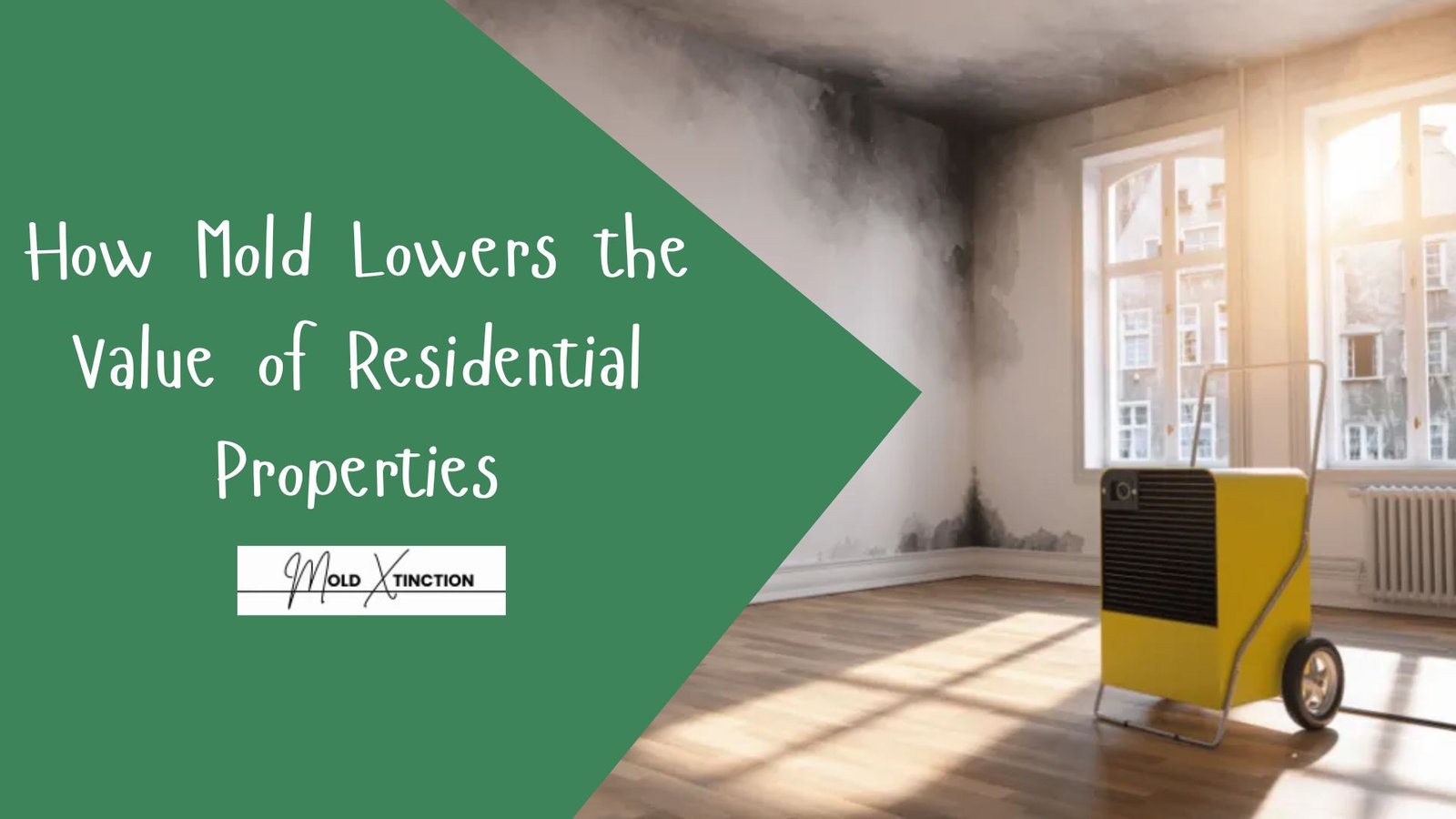I will be sharing with you today how mold lowers the value of residential properties and recommended tips to remedy the situation.
Do you have a building, but you have difficulty selling it? If it has mold, then it’s a red flag already.
When we think of what we can do to decrease the value of a home, we usually come up with cracked tiles, outdated paint, or plumbing problems. Mold is very easy to overlook, and most individuals have failed to take note of it, therefore leaving it behind.
Mold is a silent monster that can live in the dark corners of the walls, under the floor, or in humid places. It can make your house ugly, stink, and even cause serious health effects.
But it’s more than that; mold can scare away customers, undermine the infrastructure, and reduce the market value of your home in no time.
This article will explain how mold can devalue residential homes in simple terms. You will learn why it’s worth fixing it as soon as possible, the right way to preserve your home, your health, and your investment. This is one thing you must know, especially if you’re selling your home now or in the future.
What's In This Article
ToggleHow Mold Lowers the Value of Residential Properties

Then what exactly is the impact of mold on the price of a home and why is it something every homeowner must consider a problem?
1. Mold Scare Away Buyers
Before someone buys any property, he or she will first of all inspect the house. If a mere look gives them a wrong signal, they will start becoming unsecure, uncomfortable, and uncertain that the house is not in good condition.
Its easy to spot because they wont hide if they are available no matter how you try to brush it aside on your own. Its always around places like – the wall, the ceiling, or and you can post them around the window area.
Another thing that will make them know is that they will perceive the musty smell unless the potential buyer doesnt work with a home property expert.
The majority of buyers will view it as a problem of water, a health hazard, and high repair costs due to mold. No matter how beautiful the rest of the house is, mold is the only thing they remember. This makes them either bid nothing or just way below the asking price.
Mold brings insecurity to homes, and no one will pay a premium price for a home that has extra work to be done or has problems that can’t be seen.
2. Home Inspectors Don’t Miss Mold
In the real estate industry, most serious buyers will conduct a professional inspection of the home before finalizing a transaction.
Home Inspectors are taught to look for mold, whether visible or not. When it appears in their report, it becomes one of the big negotiation points.
Buyers can demand that the mold be removed and the source of moisture be fixed, and even that inspections be done again to ensure the problem is totally fixed on the seller’s part. When the seller refuses, this is usually a deal killer.
Hiding or painting over the mold won’t help because an inspector will probably find it, and that will kill your credibility with the buyer.
3. Mold Causes Structural Damage
Mold doesn’t sit on the surface. It grows into the house materials like wood, drywall, and insulation. It wears out those parts of the house over time even more if the source of the wetness is chronic.
An untreated mold issue means tearing out and disposing of whole sections of walls or flooring. When it’s on the roof, it could be the leaking roof or rotten wood in the ceiling, or attic.
It’s damage that will cost time and money to fix. And until then, the value of your property is decreasing.
4. It Affects Your Home’s Appraisal Value
A mortgage company requires a home appraisal before it issues a loan. This is where the licensed appraiser will come to value your home and estimate the amount of your home.
If there’s any evidence of molds or it should be mentioned in your inspection report, and the appraiser may reduce the value of your home to reflect the cost of mold removal and repairs.
This means your home will be valued less than what you asked for, and this can be a hindrance in getting a loan, and also, it would be tough to sell it.
It may not get funded even if you find a buyer because the official value is decreased by the mold.
5. Insurance Might Not Cover Mold
Many homeowners assume that insurance will cover whatever damage is caused by water-it’s not the case with mold. There are instances where insurance companies don’t cover mold, except in sudden damage like a burst pipe.
If mold has been growing gradually without maintenance or annoying leaks, insurance might deny your claim.
It simply means you’re left with the cleanup bill on your own. And did the insurance company find out you made a past mold claim, then it may increase your premium and worst, cancel your policy.
Another issue that buyers will be concerned with is the insurance history. A mold claim in the record can be harder or costlier to cover in the future, and that, too, can scare them.
6. Health Risks Are a Dealbreaker
Mold is not something anybody should welcome. It can cause allergies, asthma, headaches, skin rashes, and breathing difficulty, more so in children, the elderly, and those with underlying health conditions. Buyers with families avoid homes with mold because they don’t want their kids to get sick. Although the mold is contained in one small room, it can be assumed that it can spread to other rooms, and that’s what kills the deal.
Health is personal, and to many, health is the number one reason to walk away from a moldy house at any price.
7. Mold Makes Homes Hard to Sell
Houses with mold take longer to sell. Even at a discount, buyers won’t buy it.
When a home sits on the market too long, it becomes devalued even without reason as people assume there must be a problem with it. Realtors know that homes that have been on the market now won’t sell later, even if you fix the problem.
Sellers in other cases are wound up accepting prices way lower than the price the house would have gotten if the mold didn’t exist in the first place.
8. The Cleanup Costs Eat into Your Profit
To be honest, the mold removal is not cheap, especially when the problem is already widespread.
Depending on where the moisture is coming in, you may have to pull off walls, take out drywall, re-staining, and even have to replace parts of the plumbing or roofing.
All this eats into your selling profit. You’re spending the money you could have put in a new home or savings, all to get the house sellable again.
Worse still, if not done well, the mold will come back and kill buyer confidence and your investment, too.
How to Stop Mold from Hurting Your Home’s Value
Prevention of mold is much simpler than a cure. Mold reproduces fast once it develops, and this may mess up your chairs, walls, and floors. It may also cause you to feel sick.
To stop mold, then, make your home dry and clean.
The following are some immediate tips on how to make your home safe:
- A quick fix to plumbing problems and leaks
- Make use of fans in the kitchen and bathroom
- Your house should have enough ventilation and it should not be wet or dam in any way..
- Hidden places like behind the fridge or under the sink should be checked and exposed to heat or fresh air.
- A dehumidifier should be applied from time to time if you notice dampness in the room to remove the moisture.
You should know that any house that has a dry and clean environment doesn’t easily have mold.
Things You Can Do Once You Discover the Presence of Mold
Why should you look away when you spot mold? You shouldn’t do that; you should find a way to eradicate it before it spreads.Mold is a growing organism and can become a huge issue with the smallest amount of time or space.
It can destroy your walls, floors, and even air. Act fast, clean it up right, and keep it dry to prevent it from coming back.
Here’s what to do:
- Find the source of moisture and fix it.
- Don’t clean it yourself, especially with bleach or paint—it doesn’t work long term.
- Call a mold remediation service.
Why You Should Call the Intervention Of A Mold Remediation Service.
Mold specialists can save your home from mold damage.
Here’s what they will do:
- Remove all the mold with care and safety
- Use the right equipment so the mold won’t spread
- Repair anything damaged by the mold, like a wall or the floor
- Find out what caused the mold, e.g,. leakage or excessive moisture
- Fix the cause of the mold so it won’t come back
- Air filter and air fresh the room again
- Wipe the area dry to prevent mold growth in the future
- Make sure that after the job is done, your home is safe and clean
All these will make sure your home is good. If there is mold, you will easily fall sick. Don’t try to do it on your own, especially when it has outgrown. Hiring the experts is better than letting the professionals do the job properly.
Conclusion
Mold itself is a big problem that can reduce the value of your house. Not only does it break walls, ceilings, and floors, but it also gives a bad impression of the house and makes it seem unhealthy.
A single mold can scare off the buyers and cost you a lot of money in repairs, despite the other parts of your house being perfect.
This can reduce the value of your house and sell it. You are planning to sell your home, or it’s you who just want to maintain your unit in good condition, it would be best that you deal with mold as soon as you see it.
Resting is just going to lead to addiction. The sooner you call a mold removal service, the sooner you can keep your home and your family safe, keep your health, and avoid losing money on your property.


